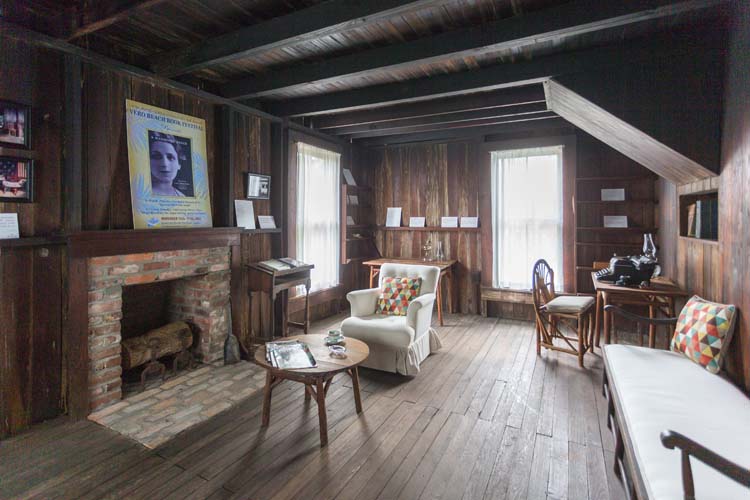
After a story in Vero Beach 32963 revealed the historic, 108-year-old Laura Riding Jackson house was facing a costly relocation from its current location on the Environmental Learning Center’s Wabasso campus, house foundation president Marie Stiefel scheduled a public meeting to discuss options.
The meeting, which took place in March at the Laura Riding Jackson Writing Center on 14th Street, revealed widespread interest in the quaint house, which is one of the few authentic Florida Cracker homes still standing in the county.
“We have felt alone – but we’re not,” said Stiefel.
The house’s uncertain future came to light last summer when house foundation board members met with ELC’s new leadership to discuss an ambitious multimillion-dollar expansion plan the environmental center has undertaken.
They were told the ELC plans don’t include an ongoing role for Laura Riding Jackson’s one-time home. Stiefel said no specific timeframe was provided for when the structure would have to be moved, leaving the board uncertain about how best to proceed.
At the March meeting, Indian River State College Provost Casey Lunceford talked about the possibility of moving the house to the college’s Vero Beach campus, which offers a venue compatible with the home’s many historic and literary associations.
“It’s ideal,” Lunceford said. “We like the educational aspect. The west side of our campus is very open and natural. Accessibility is not a problem. We have the space, and we’d be glad to host it.”
Indian River County Conservation Land Manager Beth Powell had ideas as well, suggesting two sites under her department’s purview that could work well for both the foundation and the county.
She pointed out the benefits of combining historical and environmental elements to attract a wider demographic, appropriate since Jackson was herself an environmentalist whose home was built of materials from its surroundings and designed to make the most of wind, rain and natural light.
Powell said the house could be a good fit for the South Prong Slough Conservation Area, 37.5 acres on the south side of County Road 510 west of 66th Avenue. The county recently and reluctantly demolished a hurricane damaged Cracker home on the property.
Replacing it with the Jackson home, of similar vintage, would maintain the historical ambiance of the property and support one of the objectives of the Conservation Lands program: “protection of historic and cultural resources.”
The South Prong Slough location, Powell explained, is close to the Jackson home’s original location, and the county is already moving forward with plans for expanded site access that could be “folded into [the house project] easily.” She said a county/foundation partnership would create incentive for the county to speed up work on the property.
A second possibility, Powell said, is the 59-acre Russell Grove site, off Roseland Road adjacent to the Boy Scout camp. While the Slough property is on a flood plain, the Roseland property is high and well-drained.
In either case, the nonprofit foundation would be responsible for the estimated $100,000 cost of moving the structure, but the county would do much of the site improvement work. And it was mentioned at the meeting that an individual, currently unnamed, might assist the foundation by footing the bill for the move.
Other supportive proposals came from Indian River Land Trust Executive Director Ken Grudens, who said a location on Land Trust property should be considered, and Vero Beach City Council Member Laura Moss, who suggested a city park location, and recommended the Foundation apply for Tourist Tax funding.
House foundation treasurer Susan Boyd wondered whether the property on 20th Avenue that housed the old county administration building and the school board offices might be repurposed as an “historic village,” onto which several of the county’s remaining Cracker structures, including the Jackson house, could be relocated.
Built in 1910 among the citrus groves west of the railroad tracks in Wabasso, the small frame house was purchased in 1940 by notable poet, essayist, anthologist and publisher Laura Jackson, who was associated with many leading literary figures of the 20th century, and her husband, Time Magazine poetry critic Schuyler Jackson. The couple raised citrus organically and shipped it to northern markets to support their work. The house is one of the few local examples of true Florida Cracker architecture still standing in the county.
The structure was moved to its current location, an acre leased from the ELC for $2,100 a year, renewable every five years, in 1994. While on the campus it has been open for tours and used for writing workshops and poetry festivals. The current lease expires in December.
When contacted by Vero Beach 32963 in February, ELC leaders were ambiguous about whether or when the house would have to be moved, but ELC Executive Director Molly Steinwald said at the meeting that ELC’s expansion master plan would indeed require all the campus’ acreage, edging out the historic house. She also said there was no immediate deadline for removing the house.
House foundation secretary and Jackson’s personal attorney, Rene Van DeVoorde, added that the Foundation has been in discussion with the ELC, and “they have been working with us.”
Two weeks after the meeting, Steinwald said ELC has offered to extend for one year the Foundation’s current 5-year lease and that ELC and Foundation attorneys are currently negotiating an agreement.
The Foundation’s ultimate goal is that the house continues to be “a gathering place for readers, writers and literary enthusiasts of all ages; a place of literary legacy and history, and a center for education and personal growth through writing.”



